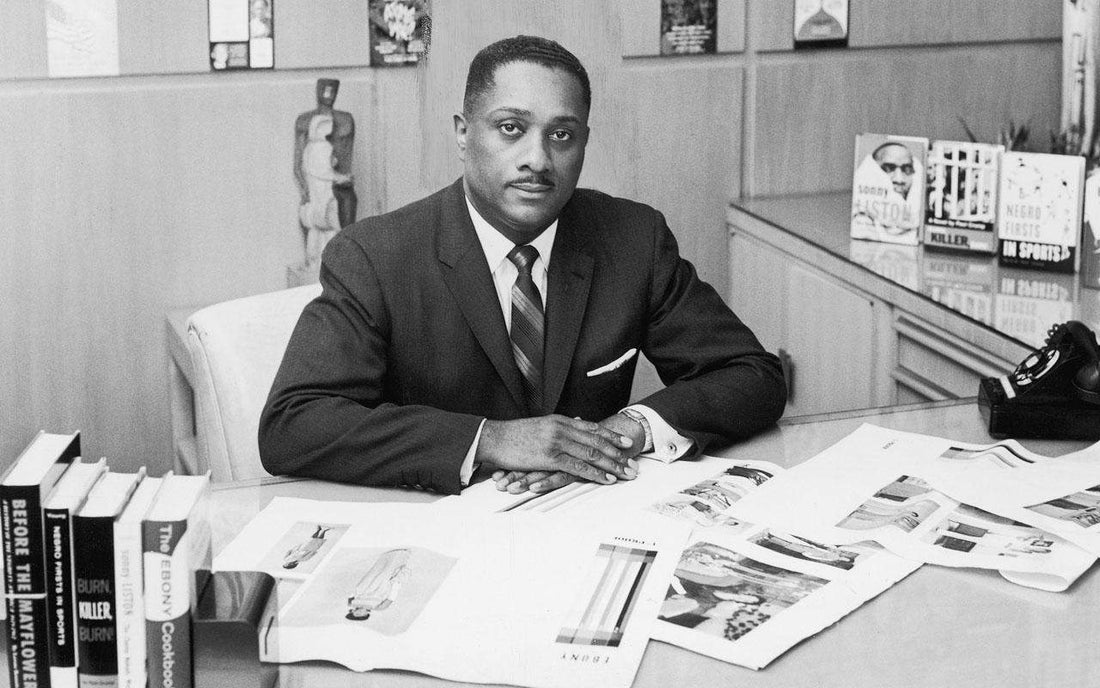


Meet Mr. Ebony: John H. Johnson
Johnson was born in Arkansas in 1918 and his family moved to Chicago during the Great Migration to the midwest from the south. As a young boy, he often was teased and bullied for his ragged clothes and country ways which made him determined to make something of himself. He transferred to a notable school called DuSable High School and studied with none other than Nat King Cole and Redd Foxx. Johnson showed motivation and leadership at a young age by becoming president of student counsel and editor of the school newspaper and yearbook.
In 1936, he received a scholarship to University of Chicago but he still couldn’t afford the other expenses required to attend school. However, after speaking at an Urban League dinner, Harry Pace (present of Supreme Life insurance) offered him a job to provide income so John could attend school. His job at Supreme Life lead to John becoming Pace’s direct assistant where he managed a monthly digest of newspaper articles. The experience of working with a black owned business inspired his dream of starting his own business.
During his work at Supreme Life insurance, Johnson created a publication fashioned after “Reader’s Digest”. Therefore, in 1942, Johnson created “Negro Digest” after securing a $500 loan from his mother. After struggling with distribution, Johnson partnered with a magazine distributor named Josephy levy and within 6 months, circulation hit 50,000. His publication covered African-American history, literature, arts, and cultural issues. After several decades of publication, "Negro Digest" was changed to "Black World".Now this was not even close to Johnson' s next publication called Ebony (something we should all be familiar with).
In 1945, Ebony magazine debuted and it was so popular that the initial run of 25,000 copies sold out immediately. Similar to Life magazine, Ebony focused on the achievements of successful African-Americans, truly shifting the image and perception of Black people in the United States. Later, Ebony began to cover social justice issues as the Civil Rights Era made waves in the 50s and 60s. Johnson made it a point to hire Black historians to accurately document African-American history and used Black models in the ads to portray positive aspects of Black culture. For the first time, there was a publication dedicated to the African-American consumer. To this day, Ebony magazine has some of the most iconic magazine covers and almost every Black celebrity from Sade, Michael Jackson, Janet Jackson, Oprah, Denzel, Barack, Diana Ross, Prince and Dorothy Dandridge have grace its covers.
In 1951, Johnson struck gold again with "Jet" magazine, despite Ebony being his most successful venture. The weekly magazine was very successful and continued to change the trajectory of how Black people were portrayed in the media. The most notable issue of Jet was the September 15, 1955 issue in which he published a picture of a Chicago–youth Emmett Till's mutilated body after it had arrived in Chicago from Mississippi. People considered Johnson's decision to publish Till's photograph his greatest moment.Johnson established Johnson Publishing which became a conglomerate of business including Fashion Fair Cosmetics and Supreme Beauty Products, and produced Ebony Fashion Fair.
With over $388 Million in sales, Johnson grew an empire of media publications, radio stations, television companies and transportation. Johnson's legacy lives on the Black owned publications and media that exists today like BET - no relation to BET's founder Robert L Johnson. He received numerous awards including the Spingarn Media in 1966 from the NAACP. Exactly 30 years later, Bill Clinton presented Johnson with the Presidential Medal of Freedom. He was inducted into the Arkansas Business Hall of Fame and is considered the founder, publisher, chairman and CEO of the largest African-American publishing company in the world! In 1982, Johnson became the first African-American to appear in the Forbes 400!
It's amazing when you realize how needed Ebony and Jet magazine were to the Black community and how influential it was in creating aspirations for Black people in America. Shoutouts to John H. Johnson for changing the narrative when it comes to the portrayal of Black people in the US and around the world.
Happy Black History Month ✊🏿


